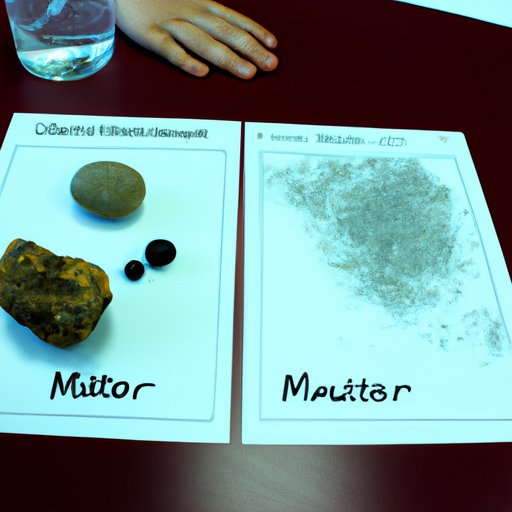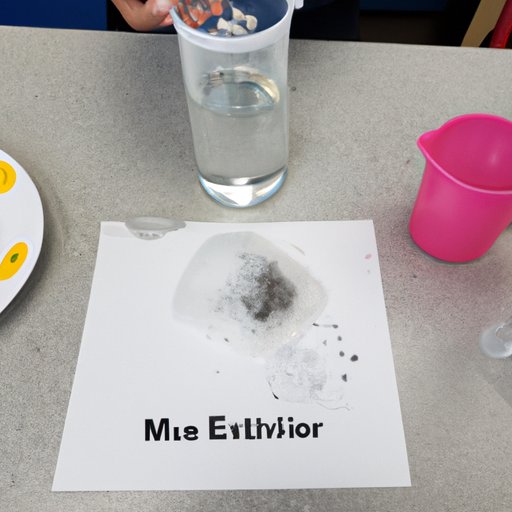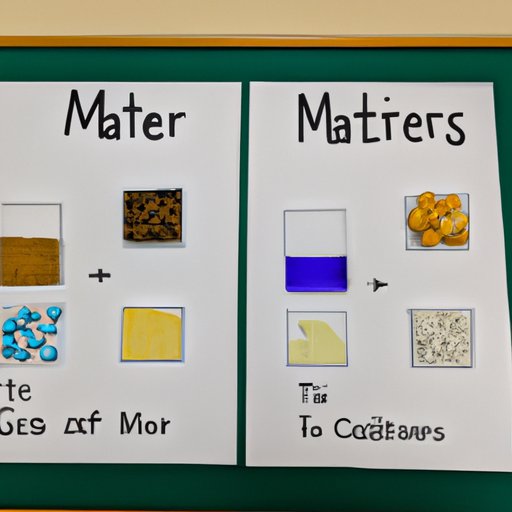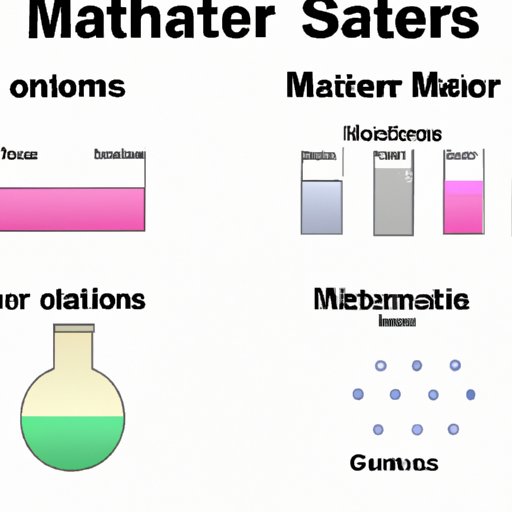Introduction
Matter is a fundamental concept in elementary science that describes anything that occupies space and has mass. In other words, it is anything that can be seen or touched. This article will delve into the concept of matter in elementary science, exploring its different properties, states, and forms. It will also analyze the role of energy in matter and compare and contrast its different characteristics.

Exploring the Properties of Matter in Elementary Science
The properties of matter are used to describe and classify it. According to Scientific American, “Properties are characteristics that help us to identify and describe matter.” The two main types of properties are physical and chemical properties.
Physical Properties
Physical properties are properties that can be observed without changing the identity of the substance. Examples of physical properties include color, shape, size, texture, and state. These properties can be easily identified through our senses, such as sight, smell, touch, and taste.
Chemical Properties
Chemical properties are properties that describe how a substance reacts with other substances. Examples of chemical properties include flammability, reactivity, and toxicity. Chemical properties can only be determined through experiments, such as burning or mixing with other substances.
Physical Changes
Physical changes occur when a substance undergoes a change in its physical properties, but not its chemical properties. Examples of physical changes include melting, freezing, and evaporating. These changes can be reversed, meaning that the substance can be returned to its original state.
Chemical Changes
Chemical changes occur when a substance undergoes a change in its chemical properties. Examples of chemical changes include burning, rusting, and decomposition. These changes cannot be reversed, meaning that the substance cannot be returned to its original state.

Investigating the States of Matter in Elementary Science
The states of matter are used to describe the form of matter at a given temperature. According to Science Learning Hub, “The three states of matter are solid, liquid, and gas.” Each state has its own unique properties, which will be discussed in more detail below.
Solid State
The solid state is the most stable state of matter. In this state, the particles of matter are packed closely together, which gives the substance a fixed shape and volume. Examples of solids include rocks, metals, and ice.
Liquid State
The liquid state is less stable than the solid state. In this state, the particles of matter are less tightly packed, which gives the substance a fixed volume but not a fixed shape. Examples of liquids include water, oil, and alcohol.
Gas State
The gas state is the least stable state of matter. In this state, the particles of matter are not packed together at all, which gives the substance no fixed shape or volume. Examples of gases include air, oxygen, and hydrogen.
Examining the Particles that Make Up Matter in Elementary Science
Matter is made up of tiny particles called atoms and molecules. Atoms are the smallest units of matter and are made up of protons, neutrons, and electrons. Molecules are made up of two or more atoms bonded together. Examples of molecules include water (H2O) and carbon dioxide (CO2).
Understanding the Role of Energy in Matter in Elementary Science
Energy is an essential part of matter. According to National Geographic, “Everything in the universe is made up of energy.” There are two main types of energy: kinetic energy and potential energy.
Kinetic Energy
Kinetic energy is the energy of motion. It is the energy that an object has due to its movement. Examples of kinetic energy include moving cars, flying birds, and spinning planets.
Potential Energy
Potential energy is the energy of position. It is the energy that an object has due to its location or configuration. Examples of potential energy include a stretched rubber band, a roller coaster at the top of a hill, and the energy stored in food.
Analyzing the Different Forms of Matter in Elementary Science
Matter can exist in different forms, such as mixtures, solutions, and suspensions. Mixtures are combinations of two or more substances that are physically mixed together. Solutions are mixtures in which one substance is dissolved in another. Suspensions are mixtures in which one substance is suspended in another.

Comparing and Contrasting the Characteristics of Matter in Elementary Science
It is important to compare and contrast the different characteristics of matter in order to gain a better understanding of the concept. Below are some comparisons that can be made:
Comparison of Physical and Chemical Properties
Physical properties can be observed without changing the identity of the substance, while chemical properties describe how a substance reacts with other substances. Both are important for identifying and describing matter.
Comparison of Solid, Liquid, and Gas States
The solid state is the most stable state of matter, followed by the liquid state, and then the gas state. All three states have their own unique properties and can exist at different temperatures.
Comparison of Atoms and Molecules
Atoms are the smallest units of matter and are made up of protons, neutrons, and electrons. Molecules are made up of two or more atoms bonded together. Both atoms and molecules are essential for understanding the structure of matter.
Conclusion
In conclusion, matter is an important concept in elementary science that describes anything that occupies space and has mass. It has different properties, states, and forms, and is made up of atoms and molecules. Energy plays an essential role in matter, as it is the energy of motion and position. Finally, it is important to compare and contrast the different characteristics of matter in order to gain a better understanding of the concept.
(Note: Is this article not meeting your expectations? Do you have knowledge or insights to share? Unlock new opportunities and expand your reach by joining our authors team. Click Registration to join us and share your expertise with our readers.)
